The Arts Space (Season 1) Jalan-Jalan
The Arts Space at Level 8 of the National Library has been re-imagined as a space that brings to life our rich collection from books and photographs to artworks and poems. Inspired by the painting, “The Couple” by acclaimed Singapore artist Tan Swie Hian, the Arts librarians have set out to create a multi-purpose space – physical and virtual, collaborative and contemplative – that not only evokes a cosy reading corner with recommended reads but a curated space for displays and exhibitions.

Season 1, JALAN-JALAN (a Malay word meaning to stroll or go for a walk), kicks-off from end-April 2018 through to mid-November 2018. We have curated a thematic display with paintings by Singapore artists in our collection setting the scene and which have been put up throughout Level 8. Encompassing these artworks are resources which are on display within the Arts Space with more available online through this resource guide.
Why JALAN-JALAN? We want to take you on a journey to revisit some of Singapore’s old buildings and street scenes as depicted by the paintings through three different trails (sub-themes) – Soul City, Ann Siang Revisited and Shop the Past. Read on to find out more and to discover home-grown paintings, artists, poems and a host of other resources.
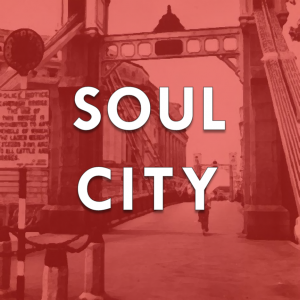 |
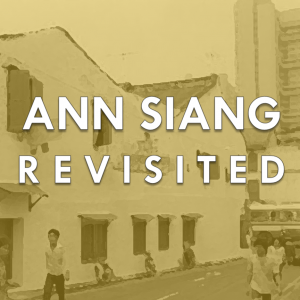 |
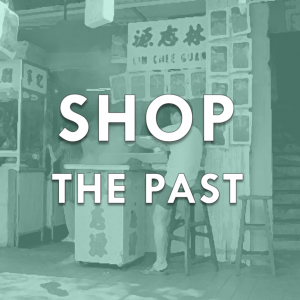 |


Cityscape artworks are rich emblems of public memory and private recollections. Juxtaposed alongside city literature by Singapore writers, they fill unspoken spaces in the collective memory of its citizens and mirror the transformations in our cultural geography as we shape-shift to become a ‘smart city’.
This series of paintings form a visual narrative of Singapore’s growth story seen through landmarks located along the Civic District including Cavenagh Bridge, the Padang, the Convent of the Holy Infant Jesus (CHIJ) chapel (now CHIJMES Hall) and the old National Library Building at Stamford Road.
The nation’s quest for constant re-invention is exemplified by poet Edwin Thumboo’s twin library poems “The National Library, nr Dhoby Ghaut, Singapore” and “National Library, 2007, Bugis” which feature the old and new libraries respectively and articulate an ongoing pursuit of knowledge amid calls for innovation. The sleek contours of the current National Library building pay tribute to the virtues of “life-long learning” in a digital era.
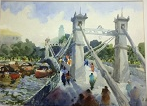
Singapore River – Cavenagh Bridge
Watercolour on Paper
Tong Chin Sye
Tong Chin Sye (1939 – )
Trained in both Western and Chinese art, Tong is a well-known multimedia artist, and has painted extensively in watercolour, acrylic and oil. A second-generation Singapore artist, Tong’s works document the rapidly changing street scenes and cityscapes since the 1960s, providing a window into the sights and scenes of an older Singapore. Tong graduated from the Nanyang Academy of Fine Arts (NAFA) in 1960 and was a part-time lecturer in Western Art at NAFA from 1995-2010. He was the winner of the Tan Tsze Chor Art Award in 1992 and represented Singapore at the 1998 Flemish Watercolour Days in Zaventum, Europe.
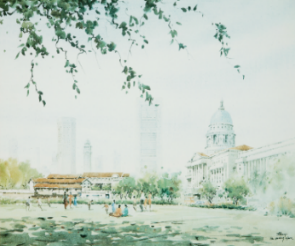
Impressions of Singapore – The Padang
Lithographic Reproduction
(Limited edition art print no. 733/950)
Loy Chye Chuan
Loy Chye Chuan (1940 – )
A self-taught artist, Loy started painting in 1958 and established himself as a watercolour artist by learning from other established artists like Lim Cheng Hoe in the 1960s, eventually developing his own style. Loy’s works include landscape scenery and street scenes of an older Singapore, using bright colours to inject a fresh and lively feel to them. Loy is one of the thirteen founding members of the Singapore Watercolour Society, which was established on 18 August 1969.
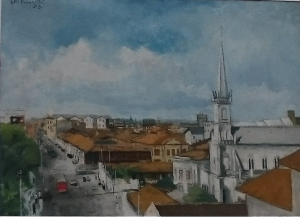
Looking along Victoria Street with the Convent Chapel at the Corner
Oil on Canvas
1958
Lai Foong Moi
Lai Foong Moi (1931 – 1994)
Initially studying at Nanyang Academy of Fine Arts (NAFA) as a student of Georgette Chen, Lai was awarded a French government scholarship to study at École Nationale Supérieure des Beaux-Arts in Paris, where she graduated in 1958. While in Paris, she received a mention honourable in Société des Artistes Français’ Salon of 1957. Painting in the Nanyang style, Lai is known for her later works of portraits and figures, while her landscapes offer an insight into her sensitivity to her environment.
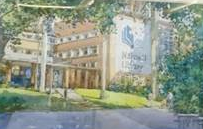
Untitled [National Library Building, Stamford Road]
Watercolour on Paper
Ong Kim Seng
2007
Ong Kim Seng (1945 – )
Eminent watercolourist Ong Kim Seng is the former president of the Singapore Watercolour Society (1991 to 2001), a Cultural Medallion winner (Visual Art) in 1990, and winner of six awards from the prestigious American Watercolour Society. He has held numerous solo and group exhibitions since his first solo exhibition, Himalayan Trek Art Exhibition, at the Asia Art Gallery in 1979. His works have been exhibited internationally in Europe, USA, Japan and ASEAN countries.
Below is a selection of related resources available from the NLB catalogue or the Internet. It is not meant to be an exhaustive list.
On Artists
- Artcommune Gallery. (2015). The Singapore modern art narrative. Singapore: Artcommune Gallery.
Call no.: RSING English 759.95957 SIN
This exhibition catalogue features Singapore artworks in four veins – traditional Chinese ink, watercolour, Nanyang style and beyond. It includes an introduction on Singapore art history, the styles and short bios of artists featured.
- Chia, W. H., & Chai, Y. C. (1982). Singapore artists. Singapore: Singapore Cultural foundation & Federal Publications.
Call no.: RSING English 759.95957 SIN
One of the earlier publications to present a consolidated picture of the Singapore art scene, this book features works by Singapore’s pioneering painters and sculptors.
- Lai Foong Moi : Catalogue of paintings. (1959). Singapore: University of Malaya. Art Museum.
Call no.: RCLOS English 759.9595 UNI
On her return to Singapore after her studies at École Nationale Supérieure des Beaux-Arts in Paris, Lai Foong Moi brought back with her the paintings created during this time. This catalogue features these artworks.
- National Library Board. (2017). Ong Kim Seng written by Nureza Ahmad. Retrieved 21 March 2018, from Singapore Infopedia.
An article providing biographical information on eminent watercolourist and Cultural Medallion winner Ong Kim Seng about his life and achievements, including some of the publications he has produced over the years.
- Tong C. S. (2012). Tong Chin Sye – reminiscences. Singapore: Pertified Arts LLP.
Call no.: RSING English 759.95957 TON
Lost street scenes and heritage landscapes are documented in this catalogue accompanying the exhibition at NIE Art Gallery of Tong Chin Sye paintings between 1961 to 2000.
On Style
- Devon, M. (2008). Tamarind techniques for fine art lithography. New York: Abrams.
Call no.: RART 763 DEV
This book covers all facets of fine art lithography, from setting up a workshop of any size to pulling a successful edition. It offers complete, illustrated step-by-step instructions for all techniques in use today as well as up-to-date health and safety information in creating lithography
- Law, Q.R. and Luakian, M. (eds.). (2016). The city Singapore book. Hong Kong: Production Q
Call no.: RSING 704.94995957 CIT
This is a compilation of artworks by a select group of homegrown artists juxtaposed alongside personal stories about life in Singapore. Packaged in a luxurious hardcover format, this publication includes an illustrated map that provides readers with a tangible guide to the artists’ narratives of the city-state.
- Tan, M.K. (1997). The evolution of the Nanyang art style : a study in the search for an artistic identity in Singapore, 1930-1960. Hong Kong: Dept. of Humanities, University of Science and Technology.
Call no.: RSING 709.5957 TAN
This thesis attempts to define the Nanyang Art Style through a study of the search for an artistic identity in Singapore by a group of Chinese emigre-artists. The first part of this academic exercise explores the general development of Singapore and the reasons that led to art being introduced and developed on an island where the initial immigrants were mainly labourers and businessmen. The second part discusses the evolution of the local art style in Singapore.
- Thorspecken, T. (2014). Urban sketching : The complete guide to techniques. Singapore: Page One.
Call no.: RART 743.84 THO
Urban Sketching offers readers inspiration from real-life surroundings through over 350 full-color illustrations as a tool to hone their craft. Comprising the techniques of sketching and drawing as well as a range of know-hows specific to this artistic genre, readers will discover for themselves rules on perspective that will aid in sketching landscapes, buildings, and objects accurately as well as tips on how to capture the essence of people in sketches when subjects are on the move.
- Walkowitz, D.J. and Knauer, L.M.(eds.). (2004). Memory and the impact of political transformation in public space. Durham, N.C. : Duke University Press.
Call no.: RART 720.103 MEM
This publication explores the effects of major historic upheavals on the ways in which public histories are presented the world over. It expands the scope of what is considered public history by pointing to silences and absences that are as conspicuous as museums and memorials.
- Zaihan, K. (ed.). (2011). Urban sketchers Singapore. Volume 01 : A book of on-location sketches and drawings documenting the Singaporean urban landscape. Singapore: Math Paper Press.
Call no.: RSING 704.9445957 URB
The Singapore Urban Sketchers group presents this compilation of illustrations by 33 featured artists capturing the places, memories and other vignettes of life in Singapore. Also included are descriptions of various places featured in this book, as well as interviews with select artists.
On Subject
- National Library Board. (2016). Cavenagh Bridge written by Vernon Cornelius. Retrieved 21 March, 2018 from Singapore Infopedia.
Completed in 1869, Cavenagh Bridge is the oldest bridge across the Singapore River. This article gives the history and description about the bridge along with references.
- National Library Board. (2021). The Padang written by Joanna Tan. Retrieved 21 March, 2018 from Singapore Infopedia.
The Esplanade (or Padang) was a field originally by the sea before the 1843 reclamation. This article provides information about the history and some of the historic activities from colonial times to present day.
- National Library Board. (2010). CHIJMES written by Joanna HS Tan. Retrieved 21 March, 2018 from Singapore Infopedia.
CHIJMES was originally known as the Convent of the Holy Infant Jesus, a premier girls’ school established in 1854. This article provides information on the history and its role in early education in Singapore.
- National Library Board. (2002). National Library Building (Stamford Road) written by Anasuya Balamururgan. Retrieved 21 March, 2018 from Singapore Infopedia.
Officially opened on 12 November 1960, the distinctive red-brick building was said to reflect the red-brick epoch of British architecture in the 1950s. This article gives the history and description of the now demolished building.
- Thumboo, E. (2012). The best of Edwin Thumboo. Singapore: Epigram Books.
Call no.: RSING English S821 THU
This compilation features poems by Singapore’s pioneer poets Edwin Thumboo, presented in five parts with a section on place poems, including the two aforementioned poems on National Library.

Ann Siang Road located in the historic Telok Ayer District in Chinatown begins from a road known as Ann Siang Hill and connects to Kadayanallur Street. It is named after Chia Ann Siang (1832‒1892) a wealthy Chinese businessman who built his house and estate on the site.
Situated on a hill, both Ann Siang Road and Ann Siang Hill are lined with elegantly restored shophouses, a prevalent building type in Singapore’s architectural heritage, and richly decorated terraces. Most of these buildings were constructed between 1903 and 1941. The typical shophouse is a two or three storey building with a shop on the ground floor and living quarters above.
Another heritage landmark next to Ann Siang Road is Sri Mariamman Temple on South Bridge Road. Established in 1827, it is the oldest Hindu temple in Singapore and was constructed by immigrants from the Nagapatnam and Cuddalore districts of South India. The temple, managed by the Hindu Endowments Board, was gazetted as a national monument on 6 July 1973.
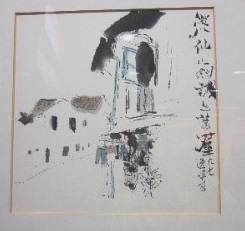
Old shophouses on the slope of Ann Siang Hill
Ink and Colour on Paper
Chua Ek Kay
Chua Ek Kay (1947-2008)
An artist who has been hailed as the bridge between Eastern and Western art, Chua Ek Kay (b. 1947, Guangdong, China–d. 8 February 2008, Singapore) is the first Chinese ink painter to win the United Overseas Bank Painting of the Year Award (1991). Chua trained under Singaporean master brush painter, Fang Chang Tien of the Shanghai School, but later developed a keen interest in Western art. The blend of traditional Chinese art forms and Western art techniques feature prominently in Chua`s paintings. He was awarded the Cultural Medallion in 1999.
Below is a selection of related resources available from the NLB catalogue or the Internet. It is not meant to be an exhaustive list.
On Artists
- Chua Ek Kay. (2007). Chua Ek Kay: along the river banks. Singapore: Singapore Tyler Print Institute.
Call no: RSING 759.95957 CHU
Article on the life history of the artist and catalogue of the exhibition Along the River Banks held at Singapore Tyler Print Institute, from 9 November – 22 December.
- Chua Ek Kay. (2011). Old campus revisited: Chua Ek Kay collection of the Catholic High School. Singapore: The Private Museum.
Call no: RSING 759.95957 CHU
Exhibition catalogue of the Chua Ek Kay’s Catholic High School paintings.
- Chua Ek Kay, Cultural Medallion Recipient 1999 Visual Arts [videorecording]. (2007). Singapore Art Museum for National Library Board Singapore and National Arts Council.
Call no: RSING 759.95957 CHU
Produced in May 2007, this video is probably the last recording on Chua Ek Kay, one of Singapore’s leading Chinese ink painters. The commentator examines and explains the influences and inspiration on Chua’s life and art, his art training and his exposition and techniques, including his practice of fusing eastern and western traditions in his art. Viewers can get a glimpse of Chua’s signature Street Scene Series, Lotus Pond Series, Reflections Series and Cao (or Grass) Series, as well as photographs of Singapore street scenes from which Chua translated into his paintings. In concluding footages, Chua shares how he felt when he was awarded the Cultural Medallion.
- No mountains, I will paint a shophouse here. (1999, September 25). The Straits Times, p. 3.
URL: http://eresources.nlb.gov.sg/newspapers/Digitised/Article/straitstimes19990925-1.2.113.3.3
This newspaper article provides a brief life history of Chua Ek Kay.
- Shetty, D. (2010, March 6). Icons in ink. The Straits Times, p. 3.
URL: http://eresources.nlb.gov.sg/newspapers/Digitised/Article/straitstimes20100306-1.2.111.2
An article on the Singapore Tyler Print Institute’s tribute to the late Chua Ek Kay with an exhibition showcasing 26 of his works.
- Singapore Tyler Print Institute. (2010). Re-visiting Chua Ek Kay : Tribute to the ink master, 5 – 20 March 2010. Singapore: Singapore Tyler Print Institute.
Call no: RSING 759.95957 CHU
Essays about Chua Ek Kay, featuring works from the exhibition, Re-visiting Chua Ek Kay.
On Style
- Cherrett, Pauline. (2002).Chinese brush painting. Singapore : Page One Pub.
Call no.: PublicationSG
Limited Preview: http://eresources.nlb.gov.sg/printheritage/detail/425fd7a6-f533-4dcf-b542-7540183a633e.aspx
The book provides directions for painting a wide range of subjects, including flowers, trees, animals and landscapes and also an overview of Chinese brush painting and the range of styles and techniques used.
- Goh, M (2013, March 20). It’s picture perfect Chinese ink painting. The Straits Times, p. 3.
URL: http://eresources.nlb.gov.sg/newspapers/Digitised/Article/straitstimes20130320-1.2.92
Techniques in Chinese ink painting are explained in this article.
- Goh, B. (1994, July 9). Bold new ways with ink. Business Times, p. 22.
URL: http://eresources.nlb.gov.sg/newspapers/Digitised/Article/biztimes19940709-1.2.27.8
This article explores new techniques revealed in works displayed by the Soo Bin Art Gallery.
- Kuo, J.C. (2010). Chinese ink painting now. New York: Distributed Art Publishers.
Call no.: RART 751.4251 KUO
This publication surveys the recent trends in ink art, featuring artists from Mainland China and in Hong Kong, Taiwan, Europe and North America. Fifty-nine artists are featured, along with their artworks and accompanied by short profiles.
- The art of Chinese brush painting: Ink, painting, inspiration. (2009). Tokyo; Tuttle Pub., Rutland, Vt.
Call no.: RART 751.4251 SEL
The opening chapter provides a brief survey of the Chinese tradition of ink brush painting. Also featured are chapters on calligraphy and painting guides on specific motifs such as orchids, landscapes and bamboo. Available as an eBook as well.
On Subject
- Ann Siang Hill general view [Photograph]. Retrieved 21 March, 2018 from PictureSG.
A 1983 photograph showing Ann Siang Hill, from Club Street.
- Annaliza Bakri. (2017). Sikit-sikit lama-lama jadi bukit. Singapore: Math Paper Press. Call no: RSING 899.281 SIK
This bilingual publication includes a poem by Isa Kamari on Haji Lane.
- National Library Board. (2016). Ann Siang Road written by Thulaja, Naidu Ratnala. Retrieved March 21, 2018 from Singapore Infopedia.
A short introduction to the history of Ann Siang Road, which was named after a wealthy businessman. The article focuses on the historic buildings around the area and the richly decorated shophouses.
- National Library Board. (2016). Sri Mariamman Temple (historic site next to Ann Siang Road) written by Tan, Bonny and Chew, Valerie. Retrieved March 21, 2018 from Singapore Infopedia.
This Infopedia article describes the oldest Hindu temple on the South Bridge road which also the reason why the temple was called as South Bridge Mariamman temple. The article gives a brief account of the history, the development and the historical places around the temple.
- Singapore. Archives and Oral History Dept (1983). Chinatown : an album of a Singapore community = 牛车水. Singapore: Times Books International : Archives and Oral History Dept. Call no: RSING 779.995957 CHI
This publication features photographs and other documents exhibited at the “Exhibition of Chinatown” organised by the Archives & Oral History Department from 31 March – 10 April 1983. The images and documents come with brief write-ups and captions. A map (circa 1846) by Government Surveyor Mr. John Turnbull Thomson is featured on p.16, which includes areas around Ann Siang Hill (then Scott’s Hill).

Singapore’s colourful shopping history is captured in these paintings of days gone by, where one could buy produce or furniture and homewares from shophouses, queue up for street peddlers who lined the streets, and soak in the mood and late-night treats offered by various hawkers in markets.
The shophouse is a recognisable architectural icon in Singapore’s building heritage. Used either as a residence, a commercial space or both, the shophouse has a unique five-foot way along its street front. This also gave rise to the term “five-foot-way traders”, craftsmen who plied their trade along the narrow walkway. These traders included fortune-tellers, letter writers, barbers and others. Bustling businesses in the shophouses spanned from selling homewares made of rattan and copra to Chinese medicinal halls.
The different shades of watercolour and ink in these paintings and excerpts of old Singapore street scenes record the old and vanishing scenes of Singapore as she underwent rapid urbanisation and modernisation.
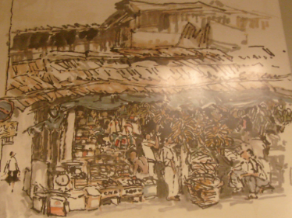
街景 (Street Scene)
Ink and Colour on Paper
Lim Tze Peng
Lim Tze Peng (1921 – )
Lim Tze Peng started his art practice in the 1950s and is best known for his ink paintings of old Singapore scenes, particularly that of the Kampungs, the Singapore River and Chinatown. Besides painting, he also practiced calligraphy and developed a style which he named “muddled calligraphy” (糊涂字). Lim has been awarded several awards for his achievements in and contribution towards the arts, including the Cultural Medallion in 2003 and Meritorious Service Medal in 2016.
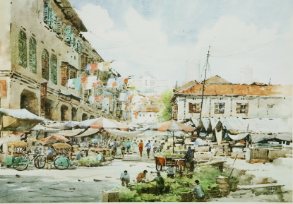
Sago Street, Chinatown
Lithographic Reproduction
Loy Chye Chuan
Loy Chye Chuan (1940 – )
A self-taught artist, Loy started painting in 1958 and established himself as a watercolour artist by learning from other established artists like Lim Cheng Hoe in the 1960s, eventually developing his own style. Loy’s works include landscape scenery and street scenes of an older Singapore, using bright colours to inject a fresh and lively feel to them. Loy is one of the thirteen founding members of the Singapore Watercolour Society.
Below is a selection of related resources available from the NLB catalogue or the Internet. It is not meant to be an exhaustive list.
On Artists
- 25 years of watercolour painting in Singapore. (1994). Singapore: Singapore Watercolour Society. Call no.: RSING 759.95957074 TWE
Published in conjunction with the Singapore Watercolour Society’s 25th anniversary exhibition, this book includes a brief history of the society as well as the exhibited artworks and artists. A number of the paintings are also paired with poems by Singapore poet, Koh Buck Song.
- Artists preserve Singapore’s roots. (1983, May 5). The Straits Times, p.2. Retrieved from NewspaperSG.
URL: http://eresources.nlb.gov.sg/newspapers/Digitised/Article/straitstimes19830505-1.2.160.2.4
Reports of more than a dozen artists documenting the life and streetscapes of Chinatown before the demolition works were slated to begin on derelict buildings. The groups of artists mentioned include Loy Chye Chuan and Choo Keng Kwang.
- Lim Tze Peng, Cultural Medallion award 2003 (Art). (2003). [Video]. National Library Board and National Arts Council.
URL: http://eresources.nlb.gov.sg/arts/website/contents/ArticleDetails.aspx?Id=455ef05c-5adb-40d1-aeaf-e2399269b2da
A 16-minute video chronicling Lim’s artistic development, creative process, governing philosophies, and visual vocabularies. Highlights include his oeuvre of artworks which capture the heritage and history of tropical Singapore and Southeast Asia.
- Lin, Z. P. (Lim Tze Peng). (1991). Reminiscence: Old Singapore (Lim Tze Peng). Singapore: Beaumont Publishing.
Call no.: RSING Chinese 759.95957 LZP
Features 81 of Lim’s artistic representations of Singapore’s recent past, in particular Chinatown and the Singapore River and a bilingual introduction (English and traditional Chinese) by Wai Hon Chia.
- Loy, L. C. (2011). Loy Chye Chuan’s watercolour world. Singapore: Loy Chye Chuan. Call no.: RSING Chinese 759.95957 LCC
Includes a foreword by the artist which briefly introduces his artistic philosophy and creative journey as an artist. The book highlights Loy’s paintings chronologically from 1960 to 2011, which features his scenic artworks of Singapore, Malaysia, Brunei and China.
On Style
- Caine’s Gallery. (1995). The President’s Watercolour Selections. Singapore: President’s Office. Call no.: RSING 759.95957074 PRE -[SRN]
As part of a charity art exhibition, twenty-two watercolour artists showcased their works and raised funds for charity. In addition to the twenty-two paintings, this exhibition publication features essays on watercolour by Ong Kim Seng and Leong Weng Kam.
- National Museum. (1993). Journey of ink: National Museum Art Gallery. Singapore: National Museum. Call no.: RSING 759.95957 JOU
Published in conjunction with the exhibition of the same name, this publication includes an essay titled ‘A perspective on the development of ink painting in Singapore’ by Kwok Kian Chow and Chua Ek Kay.
- Parramon, J. M. (1993). The complete book of watercolour: the history, materials, techniques, theory and practice of watercolour. London: Phaidon Press. Call no.: RART 751.422 PAR
Encyclopedic in scope, this publication touches on the history and early masters of watercolour and takes a practical look at the material, tools and drawing needed for any aspiring watercolourists.
- Singapore Art Museum. (1999). Power and poetry: Monuments and meditations in Chinese contemporary ink painting. Singapore: Singapore Art Museum. Call no.: RSING 759.95957 POW
An exhibition publication featuring three contemporary ink artists: Chua Ek Kay, Zhuang Shengtao and Henri Chen KeZhan. Provides interpretation of brushstrokes, motifs and concepts in modern Chinese ink painting through selected artworks.
- Taylor, R. (2005). Buildings in watercolour. London: Collins. Call no.: RART q751.42244 TAY
An introductory book on painting buildings in watercolour, tips on colour, tone, perspectives and architectural details are covered. Guided steps are provided for the painting of selected building.
On Subject
- Davison, J. (2010). Singapore shophouse. Singapore: Talisman. Call no.: RSING 720.95957 DAV
An in-depth study into the history and architecture of shophouses in Singapore, this book details its defining architectural characteristics, the development of shophouse styles and contemporary uses and features of shophouses.
- Kong, L. (2011). Conserving the past, creating the future: Urban heritage in Singapore. Singapore: Urban Redevelopment Authority. Call no.: RSING 363.69095957 KON
Traces the history of Singapore’s conservation journey through policies and stories as well as the views of Singaporeans and foreigners about the urban heritage of our nation. This is one of the most comprehensive monographs on Singapore’s urban heritage conservation history, with rich photographs of Singapore streets then and now, and maps of historic districts.
- Liu, G. (1984). Pastel portraits: Singapore’s architectural heritage. Singapore: Singapore Coordinating Committee. Call no.: RSING 722.4095957 PAS
Featuring Singapore’s pre-World War II architecture, this book explores the “Singapore Eclectic style” which combined elements of Chinese, Malay, Indian and European architectural style. The book highlights facades and architectural features of 17 selected areas, which includes Chinatown and Ann Siang Hill.
- National Library Board. (2016) Five-foot-way traders written by Thulaja, Naidu Ratnala. Retrieved March 21, 2018 from Singapore Infopedia.
A short introduction to history of five-foot-ways which are unique architectural features of Malayan shophouses. The article focuses on the different trades plied along these narrow walkways as a means of earning a living.
- National Library Board. (2016). Sago Street written by Thulaja, Naidu Ratnala. Retrieved March 21, 2018 from Infopedia.
Briefly introduces the history of how Sago Street got its name, its colourful history in the early 20th century and the different names accorded to the street by different dialect groups in the past.
Photographs of street scenes are from the Lee Kip Lin Collection, National Library Board, Singapore. The information in this resource guide is valid as at April 2018 and correct as far as we are able to ascertain from our sources. It is not intended to be an exhaustive or complete history on the subject. Please contact the Library for further reading materials on the topic.
All Rights Reserved. National Library Board Singapore 2018.

